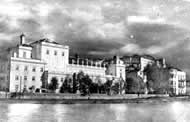History of the Macedonian Theatre
  The beginnings of the play in theatre lie in the Dionysian Bacchanalia held throughout Ancient Macedonia. The god Dionysus, through play, came among the people disguised as a male goat or bull and freed them from their difficulties, concerns, and problems. Archaeological finds in Macedonia confirm the view that classical dramatic art, in all stages of its development, left traces of its presence in Macedonia, as well. The figurine of the goddess Maenad dating from the 6th century B.C. discovered near Tetovo (hence the name of this archaeological find — Tetovo Maenad), the red-figured hydria from the 5th century B.C. unearthed near Demir Kapija, the red-figured vessel (4th century B.C.), on which Dionysus and a group of maenads are depicted, are all kept in the Archaeological Museum of Skopje as convincing evidence of the presence and wide acceptance of theatre play among the population of Ancient Macedonia. Four antique theatres have been discovered in Macedonia in Stobi, Heraclea, Ohrid, and Scupi. The beginnings of the play in theatre lie in the Dionysian Bacchanalia held throughout Ancient Macedonia. The god Dionysus, through play, came among the people disguised as a male goat or bull and freed them from their difficulties, concerns, and problems. Archaeological finds in Macedonia confirm the view that classical dramatic art, in all stages of its development, left traces of its presence in Macedonia, as well. The figurine of the goddess Maenad dating from the 6th century B.C. discovered near Tetovo (hence the name of this archaeological find — Tetovo Maenad), the red-figured hydria from the 5th century B.C. unearthed near Demir Kapija, the red-figured vessel (4th century B.C.), on which Dionysus and a group of maenads are depicted, are all kept in the Archaeological Museum of Skopje as convincing evidence of the presence and wide acceptance of theatre play among the population of Ancient Macedonia. Four antique theatres have been discovered in Macedonia in Stobi, Heraclea, Ohrid, and Scupi.
The Byzantines cherished a number of theatrical forms and these were popular in Macedonia, as well. There was drama, juggling, horse racing, and wild animal hunting. During the fairs, short stage performances were presented, entertaining and attracting people. The Slavs had also their own games, puppet theatre, and musicians. The church, in principle, was against all forms of stage games. St. John Chrysostom was a bitter opponent of all such games, as they "display debauchery and adultery, blasphemous words are spoken, and the disease enters both through the eyes and through the ears."
Many customs of the Slavs such as babari (masked dancers at Old New Year's Eve, 14th January), vasilicari (Vasilica -- St. Basil companies), koledari (Christmas carolers), lazaricari (Lazarus Day dancers), dodolari (ritual rainmaking groups), rusalii (ritual dancers with swords) include pronounced dramatic elements, often combined with singing and music. In everyday life, all of these were attached to popular beliefs and their roots can be traced to pagan customs. Through these "besovski igri" (devilish dances), as the church referred to folk customs beyond the frames of its canons, people supplemented Christianity with pagan remnants in the belief that, by certain ritual acts, they could expel evil spirits, call rain, and wish for fertile years for neighbors and friends, and alike.
During the Ottoman rule in Macedonia, the theatrical forms of karagyoz and medih (Turkish shadow puppet theatre) were introduced, which widely spread throughout the country. The rapid development of the theatre in Constantinople in the middle of the 19th century was reflected in similar development in Macedonia, particularly in Thessaloniki, but also, some time later, in Skopje. In 1897, guest performances were given in Skopje by an Armenian theatre group of Boges, which then remained in Skopje as the "Boges Theatre."
  The first theatre building on the territory of the Republic of Macedonia was built in Skopje in 1906 by the Skopje vali (governor of a vilayet) Shefket Pasha. The repertoire mostly included guest performances by theatrical groups and ensembles. About the same time, a theatre building was constructed in Bitola as well, begun in 1897 at the insistence of the Bitola vali Abdul Kerim and finished in 1908. The first theatre building on the territory of the Republic of Macedonia was built in Skopje in 1906 by the Skopje vali (governor of a vilayet) Shefket Pasha. The repertoire mostly included guest performances by theatrical groups and ensembles. About the same time, a theatre building was constructed in Bitola as well, begun in 1897 at the insistence of the Bitola vali Abdul Kerim and finished in 1908.
read more... |